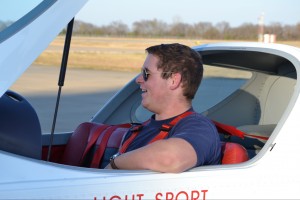By Jay Carroll
Business Staff
By senior year a majority of students know what they plan to study in college, or at least have a good idea at what they want to do in life. However, not many people are considering the field that senior Sam Shafer is taking.

Shafer has been working around airplanes since middle school when he and his dad would frequently visit Addison Airport.
“I have wanted to fly planes for a while,” Shafer said. “I used to work on them and I decided that I wanted to fly them instead of work on them.”
Going to Addison with his dad really helped Sam decide that he wanted to get his pilot’s license and pursue a career in flight. Sam told his dad that he wanted to fly and said his dad was happy for him.
“I was fascinated and excited when he told me he wanted to get his pilot’s license,” Paul Shafer, Sam’s dad, said. “I knew his flight training would require discipline and commitment, and he has applied both.”
Shafer has been working on getting his pilot’s license for over six months and he still has a lot of work left to do, but he says it is worth it and that he loves flying.
“When I’m flying it is a different feeling,” Shafer said. “The first 10 hours are getting used to the turbulence and the wind blowing you around. But after that it does not feel much different than driving a car.”
It takes a lot of time and effort in order to get a pilot’s license. For just the standard pilot’s license, one needs 40 hours of flight time. That includes dual-time (with the student and instructor), cross-country time, nighttime and individual time.
In addition to the large number of hours required, there are three tests that the student must pass as well, an oral, practice and flight test. However, the process for finding where you want to train is almost as important as the actual course.
“The first step to getting your license is to find some place you are comfortable with,” Shafer’s flight instructor Bryan Serif said. “By that I mean you have to see if you are going to like who you will be learning with and the planes that you will be flying.”
Shafer decided to pick Addison because he was very familiar with it, as he has been going there for many years.
Next year, Shafer will be going to Brookhaven Community College so he can take some classes and still fly and work on his pilot’s license at Addison. Once he graduates from community college, Sam plans on joining a flight program at Oklahoma State University or Texas Tech.
“The main reason to stay here is so I can continue to fly out of Addison, instead of changing airports and meeting new people,” Shafer said.
Shafer goes to Addison at least twice a week to fly or meet with his instructor, on top of the hours he puts in towards studying for school and the various flight exams. However, his flight instructor says that the work he puts into it has shown in Shafer’s flying ability.
“Sam as much as he likes to beat himself up, is actually a very good student,” Serif said. “I like having him at the end of my days because it gives me something to look forward to. It is really just a pleasure to teach students like Sam.”
Serif also says that Shafer’s ability to adjust to many different scenarios in the cockpit is what makes him such a good pilot, despite Shafer’s lack of studying.
“Studying is certainly not Sam’s strong suit. His adaptability in the cockpit is his biggest strength,” Serif said. “As an instructor you try to come up with many different scenarios that may arise while they are flying, and I haven’t come up with much that he has had trouble adapting too.”
After college, Shafer plans on pursuing a flying career whether it is as a private airline pilot or a commercial plane pilot.
“Now I will work on my private license, then IFR (Instrument Flight Rule), then commercial, and hopefully after that I can apply to work for a small airline or fly cargo,” Shafer said.






